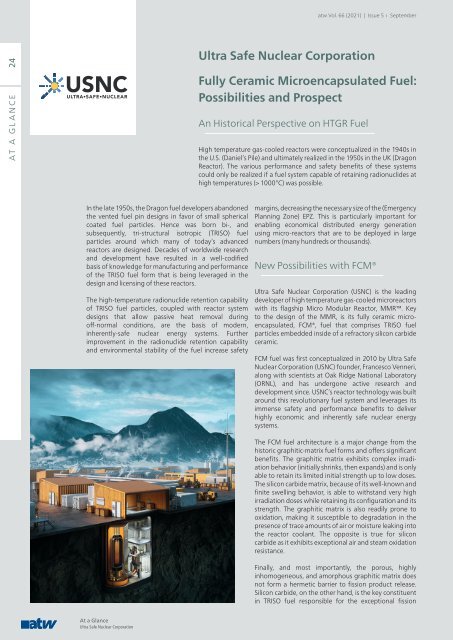atw - International Journal for Nuclear Power | 05.2021
Description Ever since its first issue in 1956, the atw – International Journal for Nuclear Power has been a publisher of specialist articles, background reports, interviews and news about developments and trends from all important sectors of nuclear energy, nuclear technology and the energy industry. Internationally current and competent, the professional journal atw is a valuable source of information. www.nucmag.com
Description
Ever since its first issue in 1956, the atw – International Journal for Nuclear Power has been a publisher of specialist articles, background reports, interviews and news about developments and trends from all important sectors of nuclear energy, nuclear technology and the energy industry. Internationally current and competent, the professional journal atw is a valuable source of information.
www.nucmag.com
Create successful ePaper yourself
Turn your PDF publications into a flip-book with our unique Google optimized e-Paper software.
<strong>atw</strong> Vol. 66 (2021) | Issue 5 ı September<br />
24<br />
AT A GLANCE<br />
Ultra Safe <strong>Nuclear</strong> Corporation<br />
Fully Ceramic Microencapsulated Fuel:<br />
Possibilities and Prospect<br />
An Historical Perspective on HTGR Fuel<br />
High temperature gas-cooled reactors were conceptualized in the 1940s in<br />
the U.S. (Daniel’s Pile) and ultimately realized in the 1950s in the UK (Dragon<br />
Reactor). The various per<strong>for</strong>mance and safety benefits of these systems<br />
could only be realized if a fuel system capable of retaining radionuclides at<br />
high temperatures (> 1000°C) was possible.<br />
In the late 1950s, the Dragon fuel developers abandoned<br />
the vented fuel pin designs in favor of small spherical<br />
coated fuel particles. Hence was born bi-, and<br />
subsequently, tri-structural isotropic (TRISO) fuel<br />
particles around which many of today’s advanced<br />
reactors are designed. Decades of worldwide research<br />
and development have resulted in a well-codified<br />
basis of knowledge <strong>for</strong> manufacturing and per<strong>for</strong>mance<br />
of the TRISO fuel <strong>for</strong>m that is being leveraged in the<br />
design and licensing of these reactors.<br />
The high-temperature radionuclide retention capability<br />
of TRISO fuel particles, coupled with reactor system<br />
designs that allow passive heat removal during<br />
off- normal conditions, are the basis of modern,<br />
inherently- safe nuclear energy systems. Further<br />
improvement in the radionuclide retention capability<br />
and environmental stability of the fuel increase safety<br />
margins, decreasing the necessary size of the ( Emergency<br />
Planning Zone) EPZ. This is particularly important <strong>for</strong><br />
enabling economical distributed energy generation<br />
using micro-reactors that are to be deployed in large<br />
numbers (many hundreds or thousands).<br />
New Possibilities with FCM®<br />
Ultra Safe <strong>Nuclear</strong> Corporation (USNC) is the leading<br />
developer of high temperature gas-cooled micro reactors<br />
with its flagship Micro Modular Reactor, MMR. Key<br />
to the design of the MMR, is its fully ceramic microencapsulated,<br />
FCM®, fuel that comprises TRISO fuel<br />
particles embedded inside of a refractory silicon carbide<br />
ceramic.<br />
FCM fuel was first conceptualized in 2010 by Ultra Safe<br />
<strong>Nuclear</strong> Corporation (USNC) founder, Francesco Venneri,<br />
along with scientists at Oak Ridge National Laboratory<br />
(ORNL), and has undergone active research and<br />
development since. USNC’s reactor technology was built<br />
around this revolutionary fuel system and leverages its<br />
immense safety and per<strong>for</strong>mance benefits to deliver<br />
highly economic and inherently safe nuclear energy<br />
systems.<br />
The FCM fuel architecture is a major change from the<br />
historic graphitic-matrix fuel <strong>for</strong>ms and offers significant<br />
benefits. The graphitic matrix exhibits complex irradiation<br />
behavior (initially shrinks, then expands) and is only<br />
able to retain its limited initial strength up to low doses.<br />
The silicon carbide matrix, because of its well-known and<br />
finite swelling behavior, is able to withstand very high<br />
irradiation doses while retaining its configuration and its<br />
strength. The graphitic matrix is also readily prone to<br />
oxidation, making it susceptible to degradation in the<br />
presence of trace amounts of air or moisture leaking into<br />
the reactor coolant. The opposite is true <strong>for</strong> silicon<br />
carbide as it exhibits exceptional air and steam oxidation<br />
resistance.<br />
Finally, and most importantly, the porous, highly<br />
inhomogeneous, and amorphous graphitic matrix does<br />
not <strong>for</strong>m a hermetic barrier to fission product release.<br />
Silicon carbide, on the other hand, is the key constituent<br />
in TRISO fuel responsible <strong>for</strong> the exceptional fission<br />
At a Glance<br />
Ultra Safe <strong>Nuclear</strong> Corporation

















